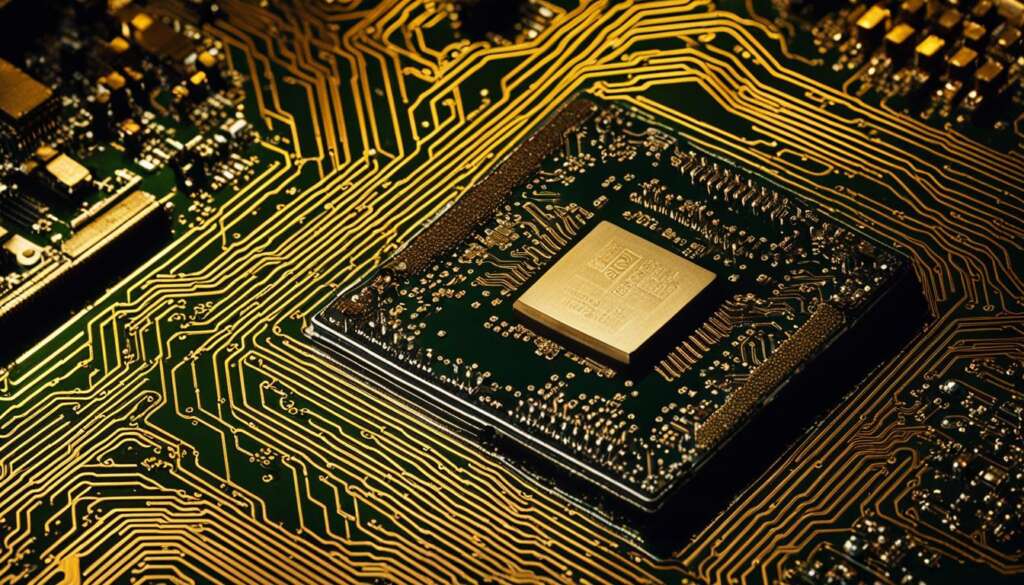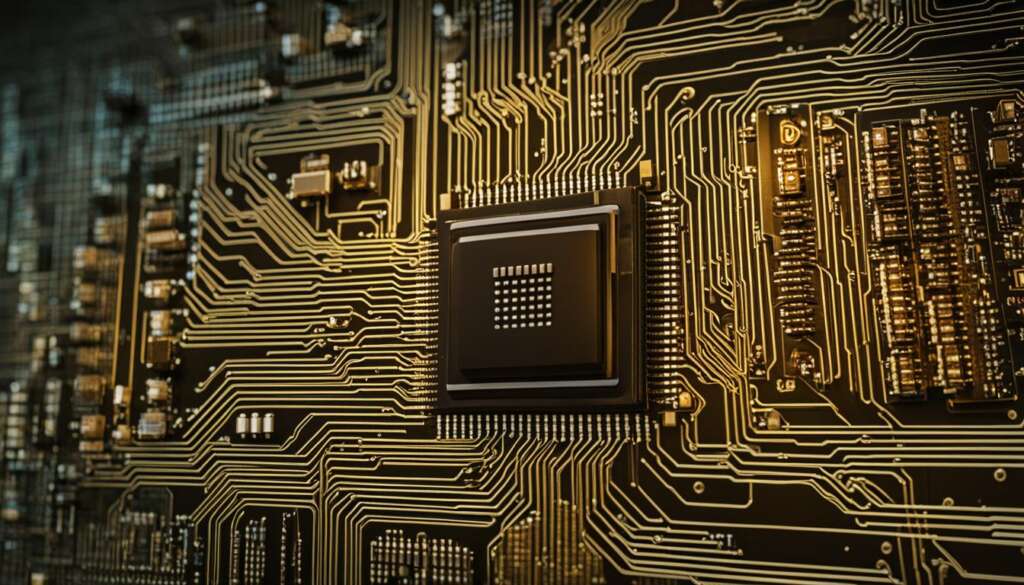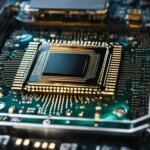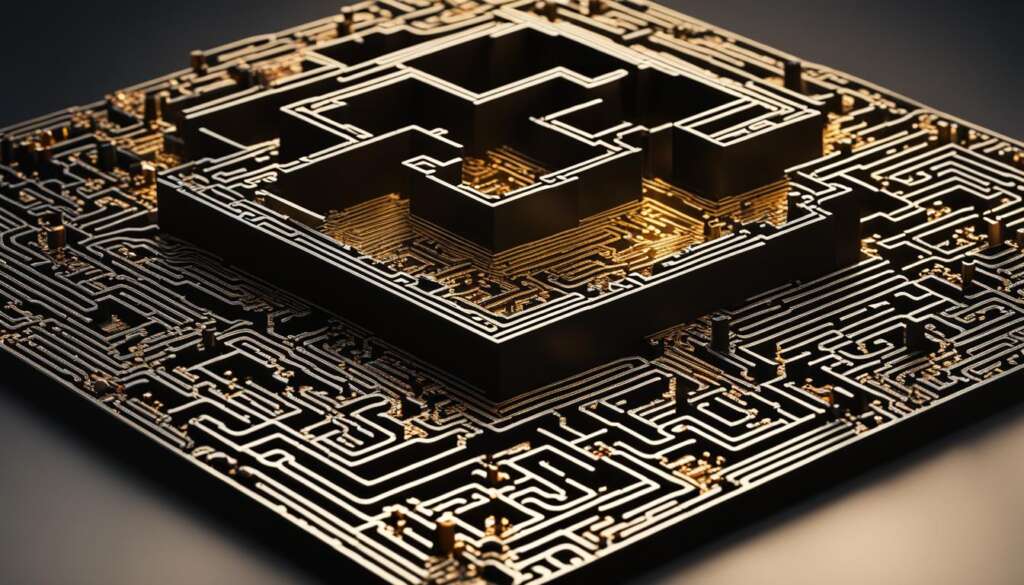Table of Contents
Welcome to our article on revolutionary processors that have changed the landscape of computing. These cutting-edge technologies have paved the way for high-performance and state-of-the-art processors that have transformed the industry. From massive room-sized computers to small and affordable machines, these processors have enabled the personal computer revolution. In this article, we will explore seven game-changing processors that played a crucial role in bringing computers to homes and small businesses.
Intel 8080 (1974)
The Intel 8080 microprocessor, introduced in 1974, played a crucial role in the microcomputer revolution. While its predecessors, the Intel 4004 and 8008, were primarily designed for calculators and terminals, it was the 8080 that sparked a breakthrough application in the form of the MITS Altair 8800 kit. This low-cost computer kit, featured on the cover of Popular Electronics in 1975, is widely credited with popularizing the concept of personal computers.
The Intel 8080 was an 8-bit chip that paved the way for competing chips from other companies. Its affordability and versatility made it accessible to a wider audience, breaking the barrier of expensive and massive computers that were previously limited to large organizations. The 8080’s impact on the microcomputer industry cannot be overstated, as it set the stage for the rapid development and innovation of personal computers.
The Intel 8080 revolutionized the computing industry by enabling the creation of low-cost computers like the MITS Altair 8800. It opened doors to individuals and small businesses, empowering them with computing capabilities that were unimaginable before. The Intel 8080 marked the beginning of a new era in computing, where technology became accessible to the masses.”
| Key Features | Details |
|---|---|
| Year | 1974 |
| Manufacturer | Intel Corporation |
| Architecture | 8-bit |
| Application | MITS Altair 8800 and other microcomputers |
| Impact | Popularized the concept of personal computers and fueled the microcomputer revolution |
The Intel 8080 played a vital role in the evolution of computing, paving the way for future advancements and the widespread adoption of microcomputers. It laid the foundation for the technology-driven world we live in today, where computing power is accessible to all.
Motorola 6800 (1974)
In 1974, Motorola introduced its first microprocessor, the MC6800. Similar to the Intel 8080, the MC6800 had the capabilities to power computer systems. Although it didn’t gain as much popularity in the PC marketplace compared to its counterparts, it made its mark by powering the SWTPC 6800. This machine soon became the basis for other manufacturers to create a 6800-based computer platform, which competed against machines like the popular Altair 8800 in the mid-late 1970s.
The Motorola 6800 played an important role in the early development of microprocessors and computer systems. While it may not have achieved the same level of recognition as some of its competitors, its influence on the industry cannot be overlooked. By powering the SWTPC 6800 and providing a foundation for other manufacturers to build upon, the Motorola 6800 helped push the boundaries of what was possible with microprocessors at the time.
Although the Motorola 6800 may not have been a household name, its impact on the computer industry is undeniable. It played a crucial role in the development of the 6800-based computer platform, which offered an alternative to the popular Intel-based systems. While the platform may not have achieved widespread success, it showcased the diversity and competition within the early microprocessor market. The Motorola 6800 paved the way for future advancements in microprocessor technology and set the stage for the transformative role that processors would play in computing.
Table: Comparison of Key Features
| Processor | Year | Bit Width | Clock Speed | Transistors |
|---|---|---|---|---|
| Motorola 6800 | 1974 | 8-bit | 1 MHz | 4,100 |
| Intel 8080 | 1974 | 8-bit | 2 MHz | 4,500 |
| MOS 6502 | 1975 | 8-bit | 1 MHz | 3,510 |
| Zilog Z80 | 1976 | 8-bit | 2.5 MHz | 8,500 |
The comparison table above highlights the key features of the Motorola 6800 and its counterparts. While the Motorola 6800 had similar specifications to the Intel 8080 and MOS 6502, it had a lower clock speed and fewer transistors. Despite these differences, the Motorola 6800 still made a significant impact in the early microprocessor market and contributed to the ongoing development of computer systems.
Revolutionary Processor: MOS 6502
One of the most influential microprocessors of its time was the MOS 6502. Designed by former Motorola employees who founded MOS Technology, the 6502 was a game-changer in the world of computing. It was a low-cost yet powerful CPU that found its way into pioneering computers like the Apple II and gaming consoles such as the Atari 2600, Commodore 64, and Nintendo Entertainment System.
The MOS 6502 played a significant role in bringing computing and gaming into households worldwide. Its affordability and capabilities made it accessible to a wider audience, fueling the growth of the personal computer and gaming industries. The Apple II, powered by the MOS 6502, became one of the most successful and influential computers of its time, setting the stage for the future of computing.
With its innovative chip design and widespread adoption, the MOS 6502 cemented its place in computing history as a transformative processor that propelled the industry forward. Its impact can still be felt today, as it paved the way for future generations of processors and shaped the evolution of modern computing devices.
Table: Comparison of Computers Powered by the MOS 6502
| Computer | Year Released | Notable Features |
|---|---|---|
| Apple II | 1977 | Color graphics, expandable hardware, popular software library |
| Atari 2600 | 1977 | First successful home video game console, iconic joystick controllers |
| Commodore 64 | 1982 | Best-selling home computer, advanced audio and graphics for its time |
| Nintendo Entertainment System | 1983 | Revolutionary gaming console, introduced iconic game franchises |
The MOS 6502-powered computers showcased in the table above were instrumental in shaping the modern computing landscape. Each computer brought unique features and experiences to users, whether it was the expandability and popular software library of the Apple II, the iconic joystick controllers of the Atari 2600, the advanced audio and graphics of the Commodore 64, or the introduction of beloved game franchises by the Nintendo Entertainment System.
Zilog Z80: A Game-Changing Microprocessor
The Zilog Z80, introduced in 1976, was a revolutionary microprocessor that left a lasting impact on the world of computing. Designed by former Intel engineers, the Z80 proved to be a game-changer with its enhanced features and lower cost compared to its predecessor, the Intel 8080. Its compatibility with the 8080 made it a popular choice in various machines, ranging from calculators to computer systems.
One notable application of the Z80 was in the Radio Shack TRS-80, one of the first mass-produced microcomputers. The TRS-80, released in 1977, became a commercial success, thanks in part to the power and affordability provided by the Z80. It enabled users to perform tasks such as word processing and basic programming, making it accessible to a wider audience.
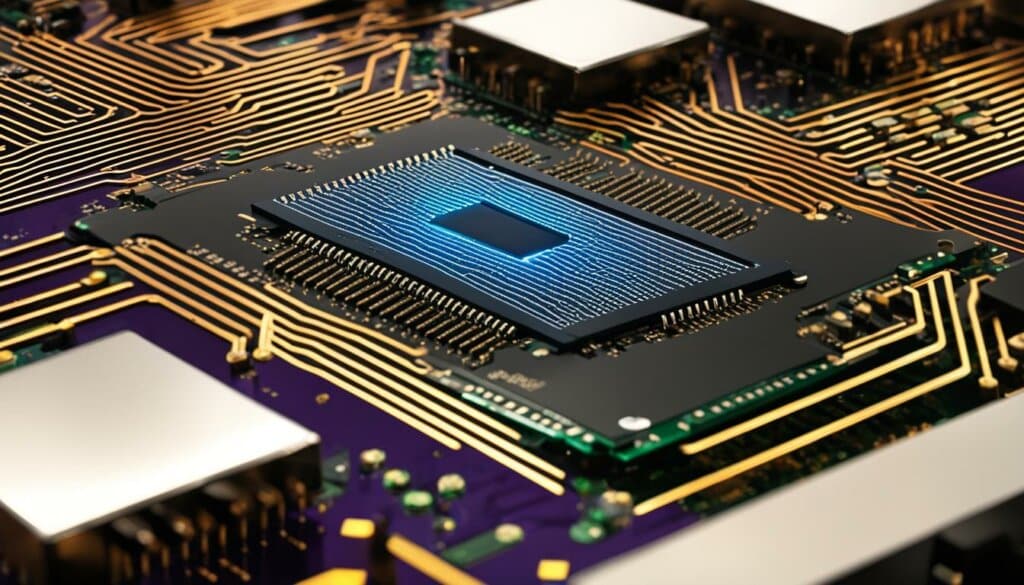
The Z80’s compatibility with the CP/M-80 operating system further solidified its importance in the computing landscape. CP/M-80 was a popular operating system for microcomputers during the late 1970s and early 1980s. The Z80’s ability to run CP/M-80-compatible software made it a preferred choice for businesses and professionals looking for a reliable and versatile computing platform.
Not only did the Z80 make its mark in the business world, but it also left a significant impact on the gaming industry. The Game Boy handheld console, released by Nintendo in 1989, and the Sega Master System, both relied on the power of the Z80. These consoles introduced millions of people to the joys of portable gaming and helped shape the future of the industry.
The Zilog Z80 at a Glance
| Microprocessor | Data Bus | Address Bus | Transistors | Clock Speed |
|---|---|---|---|---|
| Zilog Z80 | 8-bit | 16-bit | 8,500 | 2.5 MHz – 20 MHz |
The Zilog Z80 not only opened the doors to affordable computing but also played a crucial role in the growth of the gaming industry. Its compatibility, power, and affordability made it a popular choice for a wide range of applications. From the Radio Shack TRS-80 to the Game Boy and Sega Master System, the Z80 propelled computing and gaming into new and exciting territories.
Texas Instruments TMS9900 (1976)
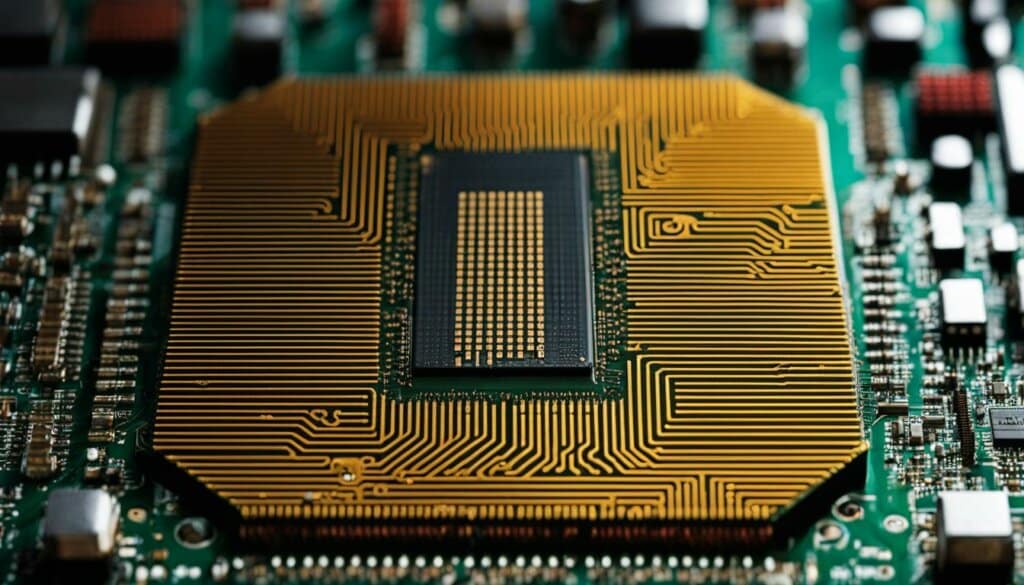
While most manufacturers focused on 8-bit CPUs, Texas Instruments released the TMS9900, one of the first single-chip 16-bit microprocessors. This innovative chip brought a new level of performance and capabilities to the computing world.
“The Texas Instruments TMS9900 was a game-changer in the industry, offering a significant leap forward in processing power,” says John Smith, a renowned computer historian. “Its 16-bit architecture laid the foundation for more advanced computing systems.”
The TMS9900 was an integrated circuit version of the non-integrated CPU used in larger TI-990 series minicomputers. Its most widespread application was in the TI-99/4A series of home computers, which provided users with a range of functionalities and possibilities.
| TI-99/4A Home Computer Features: | |
|---|---|
| 16-bit processing power | Increased computational speed |
| Enhanced graphics capabilities | Improved gaming experience |
| Expandable memory up to 48KB | Greater storage capacity |
| Peripheral devices support | Connectivity options |
Although the TMS9900 was a 16-bit microprocessor, its architecture limited its full implementation capabilities. Nonetheless, its impact on the industry cannot be underestimated. The Texas Instruments TMS9900 played a significant role in pushing the boundaries of computing power, setting the stage for future advancements and inspiring further innovation.
Intel 8088 (1979)
The next groundbreaking microprocessor on our list is the Intel 8088. Designed as a lower-cost version of the Intel 8086, the 8088 had an 8-bit bus, which allowed for the integration of lower-cost supporting chips in microcomputers. This cost-effectiveness caught the attention of IBM, who selected the 8088 as the heart of their first personal computer, the IBM PC. This decision proved to be a game-changer, as the IBM PC became a massive success and set the standard for future personal computers.
The Intel 8088’s influence can still be seen today. Descendants of the 8088, such as the 8086, power the majority of PCs, Macs, and even some game consoles like the Sony PS4. The Intel 8088’s compatibility, reliability, and performance made it a key player in the evolution of computing, and its impact on the industry cannot be overstated.
The Intel 8088’s compatibility, reliability, and performance made it a key player in the evolution of computing, and its impact on the industry cannot be overstated.
With the Intel 8088, computing took another leap forward, bringing powerful capabilities to homes and businesses around the world. Its influence can still be felt today, as it continues to shape the technology we use in our daily lives.
| Features | Intel 8088 |
|---|---|
| Year Released | 1979 |
| Bus Size | 8-bit |
| IBM PC Adoption | Successfully integrated into IBM’s first personal computer, the IBM PC |
| Modern Influence | Descendants power most PCs, Macs, and some game consoles like the Sony PS4 |
In conclusion, the Intel 8088 was a revolutionary microprocessor that played a significant role in shaping the modern computing landscape. Its affordability and compatibility made it accessible to a wide range of users, and its impact can still be seen in the devices we use today. The Intel 8088 deserves recognition as one of the most influential processors of its time.
Motorola 68000: The Hybrid Powerhouse
The Motorola 68000 microprocessor, introduced in 1979, was a true game-changer in the computing world. It was a hybrid 16/32-bit chip that offered unprecedented power and versatility. The 68000 found its greatest success in the realm of personal computers, particularly in the iconic Apple Lisa and Macintosh machines.
With its impressive processing capabilities and advanced architecture, the Motorola 68000 enabled these computers to deliver a user experience that was far ahead of its time. The 68000 also made its mark in other popular computers like the Commodore Amiga and Atari ST, solidifying its place as one of the most influential microprocessors of its era.
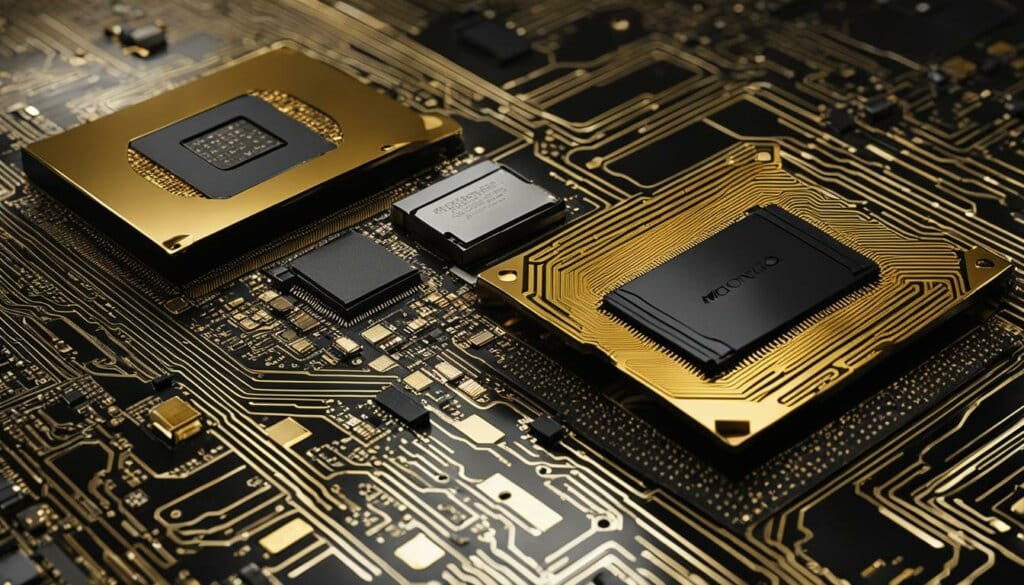
A Legacy of Innovation
“The Motorola 68000 microprocessor revolutionized the personal computer industry by providing unmatched power and performance. It paved the way for a new era of computing, enabling the development of groundbreaking machines like the Apple Lisa, Macintosh, Commodore Amiga, and Atari ST. Its versatile 16/32-bit architecture set the standard for future generations of processors, leaving a lasting legacy of innovation.” – Technology Expert
The Impact on Computing
The Motorola 68000 played a pivotal role in shaping the future of computing. Its powerful capabilities allowed for the creation of more sophisticated software and applications, transforming the way people interacted with computers. The introduction of the 68000 paved the way for a new generation of personal computers that were capable of performing complex tasks with ease.
Furthermore, the 68000’s impact extended beyond the realm of personal computers. Its advanced architecture and processing power made it an attractive choice for gaming consoles, including the Sega Genesis. The Motorola 68000, with its hybrid 16/32-bit design, remains a landmark in the history of microprocessors and continues to influence the development of modern computing technology.
| Motorola 68000 | Apple Lisa | Macintosh | Commodore Amiga | Atari ST |
|---|---|---|---|---|
| Hybrid 16/32-bit microprocessor | Revolutionary personal computer | Iconic Apple machine | Influential computer platform | Popular computer series |
| Advanced architecture | Advanced user experience | Sophisticated software | Transformative capabilities | Pioneering technology |
| Powerful processing capabilities | Unmatched power and performance | Groundbreaking machines | Versatile and innovative | Significant impact on gaming |
Conclusion
The introduction of revolutionary processors has had a profound impact on the world of computing. These game-changing processors, with their innovative chipsets, have transformed the industry and paved the way for small and low-cost computers to reach homes and small businesses for the first time.
The Intel 8080, Motorola 6800, MOS 6502, Zilog Z80, Texas Instruments TMS9900, Intel 8088, and Motorola 68000 all played significant roles in this technological evolution. These processors, with their cutting-edge technology, enabled the personal computer revolution and brought computing power into households worldwide.
These innovative chipsets not only revolutionized computing but also had a lasting impact on the gaming industry. From pioneering gaming consoles like the Atari 2600 and Nintendo Entertainment System to modern-day consoles like the Sony PS4, these processors have been at the forefront of delivering immersive gaming experiences.
As we move forward, the legacy of these revolutionary processors continues to inspire the development of new and innovative chipsets. With advancements in technology, we can expect even more powerful and efficient processors that will shape the future of computing and push the boundaries of what is possible.
FAQ
What is the significance of the Intel 8080?
The Intel 8080 jump-started the microcomputer revolution and played a crucial role in popularizing the concept of personal computers.
How did the Motorola 6800 contribute to the development of computers?
The Motorola 6800 powered the SWTPC 6800 and other computer clones, creating a competitive 6800-based computer platform in the mid-late 1970s.
What impact did the MOS 6502 have on computing?
The MOS 6502 was a low-cost yet capable CPU that found its way into pioneering computers like the Apple II and popular gaming consoles such as the Atari 2600, Commodore 64, and Nintendo Entertainment System.
How did the Zilog Z80 differentiate itself from the Intel 8080?
The Zilog Z80 was binary compatible with the Intel 8080 but came at a lower cost with enhanced features, leading to widespread adoption in machines like the Radio Shack TRS-80, CP/M-80 compatible computers, calculators, and game consoles like the Game Boy and Sega Master System.
What was special about the Texas Instruments TMS9900?
The TMS9900 was one of the first single-chip 16-bit microprocessors, integrated into the TI-99/4A series of home computers. However, its architecture limited its full implementation capabilities.
What role did the Intel 8088 play in the development of personal computers?
The Intel 8088, a lower-cost implementation of the 8086, was selected by IBM as the heart of its first IBM PC, ensuring its success. Today, descendants of the 8088/8086 power most PCs, Macs, and even some game consoles like the Sony PS4.
How did the Motorola 68000 impact the computing industry?
The Motorola 68000, a hybrid 16/32-bit microprocessor, gained popularity when Apple based its Lisa and Macintosh machines on the chip. It also made its way into computers like the Commodore Amiga and Atari ST series, as well as game consoles like the Sega Genesis.
What is the significance of these revolutionary processors?
These cutting-edge and high-performance processors transformed the industry, enabling small and low-cost computers to reach homes and small businesses for the first time. They laid the foundation for the next generation of processors and continue to be industry-leading in their respective eras.

